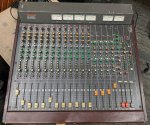hithere123
New member
I have been reading through years of your knowledge on these forums and have learned so much.
I am delving into analog recording seriously for the first time and recently just picked up a serviced Tascam 48 OB.
1. Is it normal for the capstan to start right when the machine is powered on?
2. I am also in the midst of finding the right mixer, and it seems some here are fans of the M 300 Series. They are much higher priced than they were some years back, and the M-1516 & 1508 are much more affordable than the M-308b / M-312. Is it really worth almost double or triple the price?
I am having a hard time understanding if these Tascam boards are one of the few models that allow you to easily switch between monitoring and recording without having to use extra cabling. As in do you simply go from Tape Out of the Deck to Tape in on the board?
For instance it seems you would need 16 tracks on another board to monitor and record without repatching? Am I understanding this correctly? It doesn't seem like A& H Mixwizards or Series 200 Soundcraft (No direct outs) boards have the ability that the Tascam does?
I am hoping to record to Tape, mix on the board, and send those EQ'd channels out separately to an 8 Channel interface into the DAW.
I appreciate any wisdom and time if you get a chance to answer my questions, I am strictly coming from the DAW world, so please forgive my ignorance.
I am delving into analog recording seriously for the first time and recently just picked up a serviced Tascam 48 OB.
1. Is it normal for the capstan to start right when the machine is powered on?
2. I am also in the midst of finding the right mixer, and it seems some here are fans of the M 300 Series. They are much higher priced than they were some years back, and the M-1516 & 1508 are much more affordable than the M-308b / M-312. Is it really worth almost double or triple the price?
I am having a hard time understanding if these Tascam boards are one of the few models that allow you to easily switch between monitoring and recording without having to use extra cabling. As in do you simply go from Tape Out of the Deck to Tape in on the board?
For instance it seems you would need 16 tracks on another board to monitor and record without repatching? Am I understanding this correctly? It doesn't seem like A& H Mixwizards or Series 200 Soundcraft (No direct outs) boards have the ability that the Tascam does?
I am hoping to record to Tape, mix on the board, and send those EQ'd channels out separately to an 8 Channel interface into the DAW.
I appreciate any wisdom and time if you get a chance to answer my questions, I am strictly coming from the DAW world, so please forgive my ignorance.



